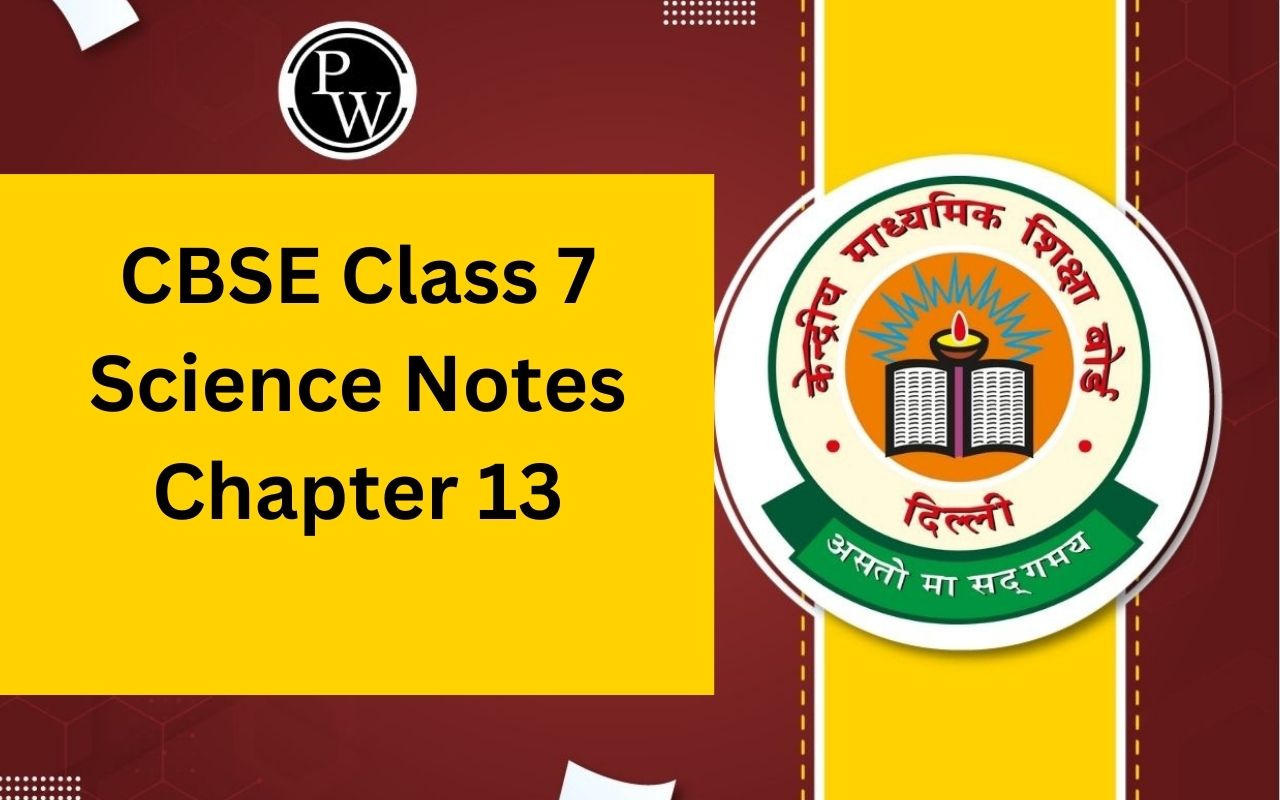

CBSE Class 7 Science Notes Chapter 13: You've come to the right site if you're seeking some excellent Motion and Time Class 7 notes. When you read the chapter, all of your questions will be answered because the notes cover the entire subject in great detail. They are useful as study notes for exams. The notes were created by professional educators in the field, keeping in mind the latest CBSE curriculum.
Taking notes is advantageous as it reduces the amount of time you need to spend reading through each chapter before a test. To succeed on your exam, all you need to do is download these notes and read through them.CBSE Class 7 Science Notes Chapter 13 Overview
Motion and time are two important science topics that are clearly and thoroughly covered in the CBSE Class 7 notes. Understanding the features and attributes of motion and time measurement is beneficial to students. Better retention is facilitated by the well-structured framework, which facilitates effective revision. The subject is better understood through real-world examples such as measuring time and comprehending how objects move. These notes are crucial for achieving academic success and laying a solid foundation in the fascinating field of motion and time. They have shown to be quite helpful in assisting pupils in achieving academic success.CBSE Class 7 Science Notes Chapter 13 PDF
These excellently crafted notes for Class 7 Science Motion and Time cover every crucial aspect of the subject. It is required of the students to download these notes and use them as needed. Pupils are free to study at their own pace and comfort. The Motion and Time Class 7 notes are available in PDF format for viewing on a device or for printing off and perusing on paper. All the student needs to do now is download the notes from this website and go over them—all the topics are covered—instead of going through the trouble of writing their notes.CBSE Class 7 Science Notes Chapter 13 PDF
CBSE Class 7 Science Notes Chapter 13
Motion
Motion is the movement of an object or the tendency of an object to move about time from its original location. Motions include, for instance, the pendulum of a clock moving, leaves falling from trees, etc. The exact path that an object travels in a specific amount of time is called its distance. The shortest distance an object travels in a specific amount of time is its displacement. Calculating distance involves multiplying speed by time. Meters and kilometers are used to express the distance. When an object's position changes throughout time, as when an automobile travels down the road, it remains in motion. If an object remains in the same location concerning time, it is said to be at rest. similar to someone standing on the ground. As a standard, time is measured in seconds, distance is measured in meters, and speed is measured in meters per second. The object moves in a straight line when it is linear or straight. circular, where the thing follows a path that is circled. Curvilinear refers to motion along a curve by the item.
Measuring Time
Many events in nature repeat after a time interval:- Morning – The rising of the sun
- Day and Night – The time between the sunrise and sunset
- Month – The time between two new moons
- Year – The time the earth takes to complete its one revolution around the sun
Basics of Standard Units
Units and their standardization
- The standard unit of distance is in meters.
- The standard unit of time is in seconds (s).
- The standard unit of speed is in meters per second (m/s).
There are two types of motions
Uniform Motion: An object is said to be moving uniformly if it moves in a straight line at a constant pace, meaning that its speed does not vary with time. Non-Uniform Motion: An object is said to be moving non-uniformly if it is moving in a straight line yet its speed varies over time.Speed

Slow and Fast Motion
If one object covers a particular distance in less time and another object covers the same distance in more time then the first object is said to be moving slowly while the second object is said to be moving faster.Measurement of Time
Time was once measured by the sun's shadow cast on various things. Simple Pendulum: The best illustration of periodic motion is this kind of clock, which is used to measure time. Clocks, or time-measuring devices, measure time by applying the principle of periodic motion. Its utilization of motion that repeats in equal intervals of time is indicated by this. Devices for measuring time come in a variety of forms. An object in to-and-fro motion is said to be in periodic or oscillatory motion.
Oscillation: The oscillatory movement.
The period is the length of time the pendulum takes to complete one full oscillation.
Seconds, represented by s, are the fundamental or SI unit of time.
Oscillatory motion: The pendulum's oscillatory motion is its to-and-fro motion. The pendulum's bob does indeed shift from its center, or mean position, to its extreme location on the opposite side.
Oscillation: One oscillation is defined as the bob moving from its center (mean position) to its extreme ends.
A pendulum's period is defined as the length of time it takes the pendulum bob to complete one oscillation.
An object in to-and-fro motion is said to be in periodic or oscillatory motion.
Oscillation: The oscillatory movement.
The period is the length of time the pendulum takes to complete one full oscillation.
Seconds, represented by s, are the fundamental or SI unit of time.
Oscillatory motion: The pendulum's oscillatory motion is its to-and-fro motion. The pendulum's bob does indeed shift from its center, or mean position, to its extreme location on the opposite side.
Oscillation: One oscillation is defined as the bob moving from its center (mean position) to its extreme ends.
A pendulum's period is defined as the length of time it takes the pendulum bob to complete one oscillation.
Measuring Speed
A speedometer is a tool used to calculate a vehicle's speed in kilometers per hour. An odometer is a tool used to calculate how far a car has traveled.Distance-Time Graph
It is employed to investigate how an object moves. On the Y-axis, the distance is displayed, and on the X-axis, the time. When the distance-time graph is a straight line, the motion is uniform. If the distance-time graph is rising, then the object's speed is rising. An item is traveling at a slower speed if the distance-time graph is descending. If the distance-time graph is parallel to the X-axis, the object is considered to be at rest. The distance-time graph's slope indicates the object's speed. The object's speed changes if the distance-time graph shows a curve.Speedometer and Odometer
The vehicle's speed is directly recorded via the speedometer in kilometers per hour (km/h). The direct distance traveled by car is measured in kilometers (km) using an odometer.Visualizing Motion
Distance-time graph
- A distance-time graph is a graph plotted between the distance (in the y-axis) and time (in the x-axis).
- The slope of a distance-time graph gives the speed of an object.
To find the speed of the distance-time graph
Speed can be calculated as follows: distance traveled/time = (final position – beginning position)/time spent by the object Additionally, a graph's slope can be used to calculate the speed of the distance-time graph. The object's speed increases with the graph's steeper slope. For instance, object A has a sharper slope in the graph below. This indicates that object A is traveling faster than object B.
Additionally, a graph's slope can be used to calculate the speed of the distance-time graph. The object's speed increases with the graph's steeper slope. For instance, object A has a sharper slope in the graph below. This indicates that object A is traveling faster than object B.
Benefits of CBSE Class 7 Science Notes Chapter 13
- provide concise, understandable descriptions of important ideas.
- simplifies difficult subjects for easier comprehension.
- Effective study aid for final exam preparation.
- improves the recall of important information.
- offers essential points and advice to help with efficient exam preparation.
- combines information to save time.
- Gives priority to significant subjects and inquiries.
- provides useful illustrations for linkages to the actual world.
- increases students' exam-taking confidence.
CBSE Class 7 Science Notes Chapter 13 FAQs
What is the measurement of time notes Class 7?
Oscillation is the process of an object moving back and forth. The time taken by the pendulum to finish one oscillation is considered the time period. The basic unit of time is denoted by the symbol “s” and its SI unit is seconds.
What is the use of motion and time?
It is used to study the motion of an object. The distance is represented on the Y-axis and time is represented on the X-axis. The motion is uniform when the distance-time graph is a straight line. If the distance-time graph is moving upwards, then the speed of the object is increasing.
What is the name of class 7 science chapter 13?
Chapter 13 - Motion And Time
🔥 Trending Blogs
Talk to a counsellorHave doubts? Our support team will be happy to assist you!

Free Learning Resources
PW Books
Notes (Class 10-12)
PW Study Materials
Notes (Class 6-9)
Ncert Solutions
Govt Exams
Class 6th to 12th Online Courses
Govt Job Exams Courses
UPSC Coaching
Defence Exam Coaching
Gate Exam Coaching
Other Exams
Know about Physics Wallah
Physics Wallah is an Indian edtech platform that provides accessible & comprehensive learning experiences to students from Class 6th to postgraduate level. We also provide extensive NCERT solutions, sample paper, NEET, JEE Mains, BITSAT previous year papers & more such resources to students. Physics Wallah also caters to over 3.5 million registered students and over 78 lakh+ Youtube subscribers with 4.8 rating on its app.
We Stand Out because
We provide students with intensive courses with India’s qualified & experienced faculties & mentors. PW strives to make the learning experience comprehensive and accessible for students of all sections of society. We believe in empowering every single student who couldn't dream of a good career in engineering and medical field earlier.
Our Key Focus Areas
Physics Wallah's main focus is to make the learning experience as economical as possible for all students. With our affordable courses like Lakshya, Udaan and Arjuna and many others, we have been able to provide a platform for lakhs of aspirants. From providing Chemistry, Maths, Physics formula to giving e-books of eminent authors like RD Sharma, RS Aggarwal and Lakhmir Singh, PW focuses on every single student's need for preparation.
What Makes Us Different
Physics Wallah strives to develop a comprehensive pedagogical structure for students, where they get a state-of-the-art learning experience with study material and resources. Apart from catering students preparing for JEE Mains and NEET, PW also provides study material for each state board like Uttar Pradesh, Bihar, and others
Copyright © 2025 Physicswallah Limited All rights reserved.
Get App










